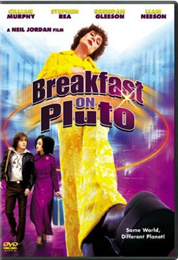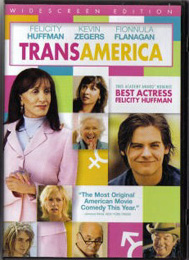Two recent movies about men passing for women raise the question: Why do we despise performance in blackface and celebrate performance in drag?
Let’s start with a definition. "Drag" is the public performance of femininity by men. Its central feature is the imitation of women. Thus
TRANSAMERICA, starring Felicity Huffman as a pre-operative male-to-female transsexual, is not a drag movie. Because it’s about achieving womanhood rather than imitating it,
TRANSAMERICA has more in common with
THELMA AND LOUISE than with TOOTSIE. It’s a road/buddy picture about finding one’s own identity and coming of age: as Huffman’s character Bree (ne Stanley) makes the journey from California to New York and back to California, she simultaneously makes the journey from adolescence to adulthood, and ultimately comes home to herself.


NOTE: Click on DVD Cover above for AMAZON Link.
It’s not a mere curiosity that TRANSAMERICA
stars a woman playing a man trying to become a woman–I would argue that the movie’s concern with authenticity, and its own genuineness, rests on that precise fact. Because Huffman actually is a woman, she understands that there’s more to womanhood than heels and a reluctance to pee where there are snakes.
The relevant point about TRANSAMERICA
is contained in a single line: Bree rejects a frou-frou dress suggested by her sister, saying, "I’m a transsexual, not a transvestite!" I have my doubts about men who think they’re "really" women–would we support someone who thought he was "really" one-handed and arranged to have the surplus hand amputated?–but they are if nothing else people willing to walk their talk: to turn into women, whatever they conceive "women" to be.
By contrast, BREAKFAST ON PLUTO is a drag picture: like
TOOTSIE, it’s about the adventures a man dressed as a woman, though without Dustin Hoffman’s I’ll-do-anything-for-a-part excuse. Rather than modeling femininity, Patricia "Kitten" Braden (ne Patrick) is merely imitating it.
So what? What’s so terrible about men imitating women? Here’s where the blackface analogy comes into play. The only reason blackface is considered an insult and drag a joke is that African-Americans won’t tolerate ridicule while the women’s movement is still trying to prove it has a sense of humor.
Certainly cross-dressing has a long history in comedy. But blackface used to be a comic staple, too: there’s a blackface scene in the original version of the Marx Brothers’ DAY AT THE RACES and another in HOLIDAY INN. Those scenes have been cut in light of contemporary sensibilities, and no one mourns their loss.
And what’s so funny about drag, anyway? Unless you think men are from Mars and women from Venus–that is, that differences in gender behavior are huge and immutable–the juxtaposition of chest hair with an evening gown doesn’t hold much interest. Certainly, the contrast between white performers and black characters was not enough in and of itself to make blackface funny. There had to be something else–and there was.
There was ridicule of African-Americans. “Aren’t they stupid? And don’t they look bizarre? But they sing and dance, and doesn’t that prove they’re happy in the confinement in which we’ve placed them?” Likewise, men who dress up as women and adopt stereotyped feminine behaviors are comical because of their stereotyped behavior, and the inference the audience is encouraged to draw is not that stereotypes are comical but that women are.
Just as in blackface African-Americans were shown singing, or dancing, or being foolish, or longing for the old plantation, in drag women are shown primping, or nagging, or having vapors, or longing for male protection. The forms are so similar that there are even two standard insulting “types” in each. Blackface offers Sambo (a shuffling rural fool) and Zip Coon (an urban dandy out of his depth), the first making fun of black people for being slaves and the second for being free. Drag presents the Glamor Girl and the Pantomime Dame (think Milton Berle in high heels, or SOUTH PACIFIC’s sailors singing “There Is Nothing Like a Dame”), the first making fun of women for their sexuality and the second for their lack of it.
The success of the Glamour Girl type shows that drag’s popularity is not really based on the comedy of incongruity. The point of glamour drag–the that-can’t-be-a-boy in the evening gown–is not comedy but simple display of the feminine. But the only reason to hire a man for this purpose, when there are plenty of women available, by definition more experienced and better qualified (and probably cheaper!), is to give men the continued right to show women how they are expected to act.
BREAKFAST ON PLUTO’s Kitten, as played by the androgynously beautiful Cillian Murphy, is a perfect Glamour Girl. Rather than try to create a life for himself, he searches for a man to define and defend him, finding everyone from a macho rock-and-roller to a would-be strangler to a second-rate magician (played by the reliable Stephen Rea). Kitten is also searching for his mother, but when he finally arranges a meeting his chief concern is whether pearls match his tweed suit. Then, when she appears, he faints, though you’d be hard-pressed to find a single actual woman who’s fainted at anything short of a three-car pileup. Kitten represents woman with all the fidelity her lover’s band the Mohawks accords to Native Americans.
The contrast between Bree’s search for her child and Kitten’s for his parent is a telling one. Bree is engaged in a fundamentally adult pursuit, while Kitten clings to his little-boy game of dress-up. Though Kitten pushes a stroller containing his friend’s baby through both opening and closing credits, the character’s real arc is from looking for his mother to finding his father. These are not the activities of an adult, male or female.
Even men who intend their drag performance as a tribute to women–and Kitten is certainly in that category as he canonizes his absent mother–are getting in our light. The original exponents of blackface intended their work as an homage to the unique folk culture of African-Americans, but that intention couldn’t protect the practice from the reasonable objection that one can’t honor people by stealing from them, and that imitation is the sincerest form of mockery.
Is drag the most important aspect of male discrimination against women? No, certainly not; nor was the elimination of Mr. Bones the most important victory of the civil rights struggle. But images
do matter; we do see and understand people according to what we’ve been told about them. The more white people present black people, the less room there is for black people to speak for themselves. The more men present women, the harder it is for women to be understood for themselves.
If drag is a badge of gay pride, you can’t tell from its use by director Neil Jordan. In
BREAKFAST ON PLUTO he keeps all the lovemaking between men off-screen, while in his better-known THE CRYING GAME an encounter between male face and male genitals climaxed in retching. Curiously, though, Jordan’s squeamishness about the connection between drag and male homosexuality is the most authentic aspect of his portraits of victimized transvestites. Most of the times men dress as women aren’t gay, at least not overtly: private cross-dressing is overwhelmingly an activity of straight men, while most comic drag–MRS. DOUBTFIRE,
SOME LIKE IT HOT, the Harvard Hasty Pudding Show–at least presents itself as such.
And if gay men regard drag as an effort to take the stigma of effeminacy and invert it, that doesn’t protect it from the objection that it insults women, any more than clitorectomy is acceptable because it’s practiced by Africans oppressed by colonialism–or blackface was acceptable because it was practiced on-screen largely by Jews.
Ostensibly drag undermines gender stereotypes by pointing out that all gender is a performance. Though this argument begins soundly enough with the observation that it’s wise to be skeptical of claims about what is “natural” to womanhood, it goes off the rails in asserting that there’s no such thing as a “woman” and that therefore one may claim womanhood on any basis, including possession of an evening gown. There’s no such thing as “race,” either, from the standpoint of biology, but that doesn’t mean that the experiences of white people and black people are identical. Put it this way: if there’s no such thing as “woman,” who is it that’s being paid 73 cents on the dollar? It’s not men in drag, I assure you.
Cross-dressing as a matter of private sexual conduct is privileged, of course, but that’s not the same thing as being entitled to public approbation. You’re privileged to swear in the privacy of your own workshop when you hit your thumb with a hammer; that’s not an argument for generalized public acceptance of profanity.
Though "trouser parts" feature women dressed as men, drag is not an equal opportunity sport. Women who dress as men are dressing up, seeking power or privilege, while men dressing as women are dressing down. Masters making fun of slaves, or at most making fun of themselves, do not equal slaves poking fun at masters. Humor is what masters get in addition to power, and what slaves get instead of it.
And if it seems humorless to refuse to share in the joke, well, it was precisely the fact that blackface impersonation was a joke–played by white people, for white people, through the medium of and on black people–which led ultimately to its condemnation. Ralph Ellison’s essay on the subject is, in fact, called “Change the Joke and Slip the Yoke,” and in it he notes, “the white man’s relish is apt to be the black man’s gall.”
Just so: man’s relish of drag is woman’s gall.
© Kelly Kleiman (9/2/06)
